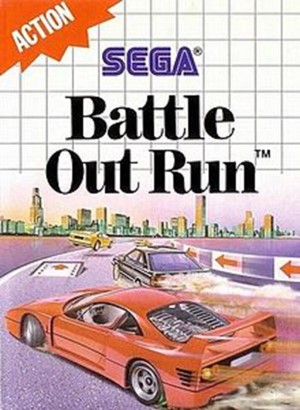
As an iteration of the OutRun series of games, Battle Out Run (note new spelling) is unlikely to stoke many folks' nostalgic fires. Indeed, price-wise it's a little more expensive than your average Master System title, which may suggest something about its comparative rarity.
Like the rest of the franchise in the good old days, you're racing against the clock. But this time with a purpose. As a bounty hunter, your F40 speeds through nine American locations (San Francisco, Grand Canyon, New York, etc.) in pursuit of a mob boss. Ramming them off the road isn't made easy by sharp bends and genocidal "enemies" determined to reverse their VWs and Moggy Minors(!) into your turbo charged red menace. There are obstacles to watch out for too, like oil spills, walls (yes, in the middle of the highway), and what managers down your local council like to call "street furniture". When your criminal mastermind has had their fenders truly bent, you are awarded points plus a bonus based on time remaining. And what do points make? If, however, the time runs out, then your bounty hunting career is done. Unless you avail yourself of a ready supply of infinite continues.
Part way through the following level you enter a roving mechanic's in the back of a truck (I wonder where that idea came from). Here, those points can be cashed in for car improvements. The engine, the wheels, the body, the chassis, all are ripe for a tinkering - for a price. You can stock up on nitro boosts as well to make it that little bit easier to race down the mobsters.
As per OutRun, there's a little radio giving you the choice of four tracks. None are anywhere up to the iconic standards of the original, but they're pleasant enough if out-of-place for a bad ass driving game.
And that's all there is to it. There's not much game here. It even lacks the choice of multiple routes that were a feature of the original. Battle Out Run makes up for this by being very, very annoying at times. Having the back end of a Beetle home in when there's no escape is a bit cheap, but unaccountably there are occasions when the bosses' cars put on a sudden spurt of speed and it's impossible to catch them up.
Okay, it's another obscure game hardly anyone will remember, so why drag it out from digital obscurity. Because it's illustrative of a trend talked about previously here and here. What I call the ephemera of gaming experiences, particularly in racing games, sees players driving round the same tracks, performing and meeting set challenges, and unlocking/buying different cars that may handle better or put out a greater MPH. It's the repetition of the same experience time after time, but with slight differences the possession of new vehicles allows for.
Old games, of course, do not have this "depth". Instead, the ephemeral experience was offered by different titles in the same genre. And by the time the late 80s had come around, the original OutRun format was looking a bit tired. It had, after all, inspired a thousand clones. What else could be done to give it a new lease of life? Roadblasters was a not-entirely convincing (or successful) attempt to marry driving with shooting. Another was Taito's Chase HQ, a cops and robbers racer that has you chasing down and bumping felons off the road. It proved popular upon its release in 1988 and saw conversions make most home systems of the day. The curious thing then is why Sega opted to develop and release its own cash-in on the chase 'em down and smash 'em up for the Master System, especially when Chase HQ was not only ported to the machine but was released at around the same time as Battle Out Run.
To ask the question, I suppose, is to answer it. The nuance here, the narcissism of small differences between the two has virtually identical gameplay separated by a flashy car and the then biggest name in driving games. In other words, the ephemera was the Sega title's selling point and one that, on this occasion, did not see it do well.
4 comments:
Ah, I loved the first Out Run when I was eight or nine.
As to the racing game experience, they later got to be much more like genuine 'simulators' - the repetitiveness is there, but it's like I imagine golf to be - about trying to perfect a skill. To the extent that I reckon my addiction to 'Grand Prix Legends' in my early 20s is what explains the fact that I, a non-driver, always seem to end up winning stag weekend karting dos, sometimes by rather embarrassingly large margins.
On the other hand, Doom didn't help me in the slightest when I went paintballing.
Perhaps the inability to aim your gun independently of the way you moved in Doom hindered your real life shooting skills ...
Now I often make some inane comments on the political section of your blog, either as vinyl or jimboo. But this is serious, I took my son to the Games Master exhibition at the National Museum of Scotland. The Sonic section was popular except for one console, the Dreamcast, in the 4 hours we spent there I only saw about three people play it. The Nintendo variants were very popular therefore highlighting the lost skill of handling the SEGA controller.
http://www.nms.ac.uk/national-museum-of-scotland/whats-on/game-masters/
I guess the Dreamcast isn't far enough away in time for kids. Looking at the older systems the graphics are, how shall we say, quaint compared with what we have today. The Dreamcast however being released in 1999 isn't that far away from sub-standard 360 and PS3 titles. That and as it was only out for 18 months before Sega nearly went under, it's unlikely to have nostalgic associations for many.
Post a Comment